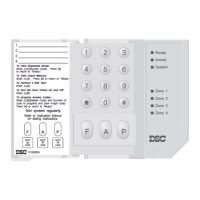
Do you have a question about the DSC PC550 and is the answer not in the manual?
| Brand | DSC |
|---|---|
| Model | PC550 |
| Category | Security System |
| Language | English |
Proper installation is crucial for security system effectiveness and requires professional evaluation.
Criminals may develop techniques to reduce system effectiveness; periodic review is important.
Intruders can bypass or disable security system components like sensing devices or warning devices.
System operation depends on adequate power supply; interruptions can affect electronic equipment.
Battery life varies; low battery monitors may fail, requiring regular testing and maintenance.
Wireless signals may be blocked or interfered with, affecting performance and reliability.
User training is essential for correct operation and emergency response to system alarms.
Smoke detectors may fail due to installation, fire type, or placement issues, and cannot sense all fires.
Detectors cannot sense all fire types equally or provide timely warning for all scenarios.
Detectors only sense motion in designated, unobstructed areas and cannot see through obstacles.
Ambient temperature and heat sources can reduce detector effectiveness and cause false alarms.
Masking or painting detection components will impair proper operation and reduce effectiveness.
Warning devices may not be heard through walls, on different levels, or due to ambient noise.
Other noise sources or hearing impairment can prevent audible warnings from being heard.
Telephone lines can be out of service, busy, or intentionally cut, affecting alarm transmission.
Occupants may not be protected due to inability to respond promptly to warnings.
Despite efforts, the system may fail to function as intended due to individual component failure.
Regular testing and maintenance are essential to find potential problems and ensure proper operation.
An alarm system is not a substitute for insurance or prudent security practices.
Read the manual, get installer training, and store for future reference before operating the system.
Security systems alert but cannot prevent emergencies; professional installation is key.
Defines key terms like Keypad, Master Code, Access Codes, Entry/Exit Delay, and Zone.
Procedure for arming the system, including zone status and exit delay.
Procedure for disarming the system upon entering the premises.
Explains the functionality and limitations of keypad commands when the system is armed.
Instructions on how to bypass specific zones to allow access while arming.
Explains how to generate a 'P' Key alarm, which can be silent or audible.
How to use the [*][7] command to operate devices like lighting or door strikes.
Arms the system while allowing occupants to remain on premises with no entry delay.
Arms the system with entry delay for entry/exit zones, allowing secure premises.
Allows arming the system without requiring an access code for immediate exit.
Explanation of the 'Ready', 'Armed', 'System' lights and Zone Lights.
Covers viewing bypassed zones, alarm memory, bell test, door chime, and code programming.
How to view zones that triggered an alarm and the system's memory clearing.
How to view system trouble conditions indicated by lights and sounder.
Procedure for programming, changing, or erasing Master and Access Codes.
How to enable or disable the door chime feature for specific zones.
How to adjust the keypad's sounder tone and backlighting brightness.
Procedure to perform a Bell Test to check siren and keypad light functionality.
Recommended weekly testing procedure, including calling the monitoring station.
Guidelines for keypad cleaning and recommended back-up battery replacement.